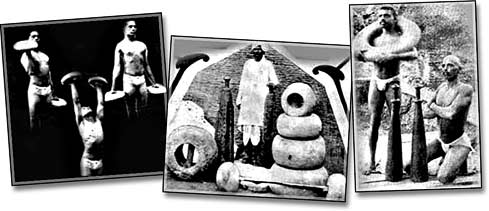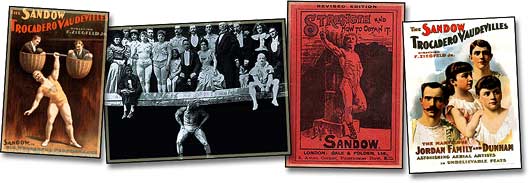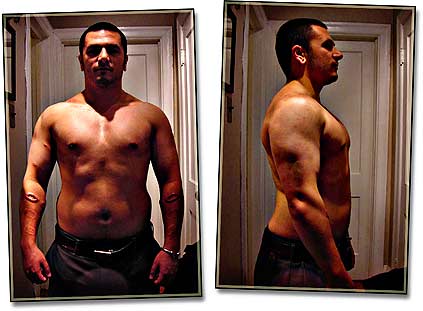
“Having a pump is like having sex. I train two, sometimes three times a day. Each time I get a pump. It’s great. I feel like I’m coming all day…”
– Arnold Schwarzenegger
By most accounts, the actual sport of aesthetic bodybuilding (different from athletic competition) is unofficially dated back to 11th century India, where athletes lifted carved stone dumbell weights (called Nals) much the same as modern fitness equipment is used to fatigue and tear our 21st century muscles. In fact, gyms in India have been traced back to this same period, and by the 16th century, it is said that bodybuilding was one of their national pastimes. There must be something intrinsically human about changing the human body, because it seems to be a fairly consistent activity throughout all recorded history, regardless of the method.

Though much has been made of the importance of physical fitness in the ancient Greek (and later, Roman) empires, the specific pursuit of bodybuilding did not yet exist. Instead, the athletes were trained in several sports and were expected to be consistent in each. These athletes were professionals in the truest sense of the word, and enjoyed great festivals in their honour at the conclusion of every sporting event. The very early Olympic games were held between cities, which each supported their own stable of elite athletes.
Unfortunately, quite a large gap exists between those early days and the middle of the 19th century, when bodybuilding began in earnest in North America and throughout Europe. At the first modern Olympics in 1896, there were two weightlifting events, variations of which continue today. Many North Americans were first exposed to bodybuilding through the strongman at traveling circus sideshows and carnivals. The man credited with ‘inventing’ many of the contemporary bodybuilding techniques was a German named Eugen Sandow, who, like many other strongmen before (and since), traveled with sideshows until the 1890’s. Before long, however, he came to see his body as a work of art, and began touring to show off his amazing physique during “Muscle Display Performances.” Hired as the personal fitness trainer to King George V, he was able to reach out to the public and advocate the potential of the human body through diet and increased physical activity. He was very influential in starting up a Ministry of Health, among other initiatives. As early as his influence was on bodybuilding, he is still revered as a deserving pioneer in the body building industry — as a tribute, the Mr. Olympia trophy is a gold statue of Sandow.
By the time Sandow died in 1925, bodybuilding had begun to take on some degree of popularity throughout England and Europe. Weightlifting equipment such as barbells and dumbbells were available commercially throughout the world, and a new generation of (mostly) men began lifting weights to create a more ‘masculine’ physique. To give you an example of the popularity of bodybuilding, who hasn’t heard of Charles Atlas? He was in his hey-day in the 1930’s, and he’s still a household name.

The “Golden Age” of bodybuilding is recognized as the years between 1940 and 1970. There were many new magazines devoted to the sport, and international organizations were in charge of hosting competitions for athletes worldwide. Most of us have an internal image, however stereotypical, of big guys lifting weights on the beach — it’s almost archetypal — but that place existed in Santa Monica, California. It has been referred to as Muscle Beach since the 1930’s. It was during this period when the basic ideology of bodybuilding was laid out: ‘train for health, strength, fitness and refined muscular development.’
For many, the bodybuilders of this period represent the height of masculinity. The competitors were huge, but still had some body fat. They were strong, but the average person could relate to them much more easily than anybody can to today’s ultra-chemically-enhanced bodies. Movies such as Tarzan and Spiderman featured bodybuilders-turned-actors in the roles of amazing super-men. Professional bodybuilders such as Lou Ferrigno and (now Governor) Arnold Schwarzenegger continued this trend from the 1970’s, taking us all the way up to today. For a great (if exaggerated) representation of bodybuilding in the 70’s, see the movie Pumping Iron. For many, that film represents the height of bodybuilding, even though those athletes are much less exaggerated than today’s.
Many believe that the sport of competitive bodybuilding has gone a little too far over the past twenty years. Whatever the case, constantly-improving supplements, steroids, and workout routines will ensure that tomorrow’s bodybuilders will be even bigger, leaner, and stronger. And probably more chemically tanned. And although all the right drugs and supplements help to refine the physiques of these athletes, it is undeniable that such an activity still takes an incredible amount of dedication and hard work. And we haven’t even touched on the subject of female bodybuilders! There are a multitude of resources on bodybuilders, bodybuilding and personal transformations on the internet. I generally try to avoid plugging other websites here, but bodybuilding.com is the BME of fitness.
Progress
It’s now been four months since I started my training, and it’s still going great. I haven’t missed any sessions (except when I’ve been out of town) and I haven’t let myself give up before an entire workout, even though I’ve felt very, very close to doing so. On occasion, the only thing that keeps me there is the thought that I know that I will recover in time. It is very often tough to push yourself without a workout partner, though I am doing my best. I find it’s easiest if I challenge myself to get the most out of my workouts.
What I’d never really considered before this month is how much the outside world can affect your dedication to consistent training. This has been a very tough month for me in many ways, and as we all know, this has a tendency to affect our bodies. I haven’t let this happen, however, and I am better off for it. I remain dedicated to my physical transformation, and though my goals are still formulating in my mind, I know I’m one step closer with every visit to the gym. I find it much easier to resist all the grossly fattening foods I used to feel so guilty about eating, and when I give in to temptation, I’m no longer riddled with that same feeling. I enjoy eating the occasional “cheat meal,” because as dedicated as I am, I still have to enjoy life. This has even rubbed off on my partner, who is now eating healthier than ever before (and seeing results after just a few weeks!) and enjoying herself at the same time. It just goes to show that you don’t have to starve yourself to lose weight — just a conscious decision to make the change for the better.
I now totally understand why “workout people” hate to miss a session. What one person calls obsession is simply dedication to another. If I miss one date at the gym, it sets me back almost an entire week. At this point I’m going to the gym six times per week: weightlifting is twice with my trainer and twice by myself, in addition to the three sessions of cardiovascular exercise I have recently undertaken. On Mondays and Thursdays I work my back, my shoulders and my arms, and on Tuesday and Friday I work my chest and my legs. Aside from having missed one session due to Thanksgiving and having trouble getting back into the swing of things, this “split routine” is going well. Certain areas of my body are reacting well to it, and others are still lagging behind. The problem with an area that’s not developing well is that it won’t improve if you just add more weight — you need to work out smarter, not harder, or the muscle fibers will not heal.
Unfortunately, on my first “alone” session without the trainer, I pushed myself a little too hard. At the time, I felt great. “Wow, I can push more weight than I thought!” But that led to problems at my next session with the trainer, because I could barely lift any weight at all. The same for the session after that. I had torn my muscles so badly that I hadn’t recovered in a whole week. It set me back and I promised myself I’d never do that again. The idea, as I’ve found out, is to stimulate the muscles into growing, not tear them to shreds so that they take forever to heal (and don’t necessarily gain you any strength or size once they have healed). Muscles get bigger and stronger while outside of the gym, and that’s why it’s important to eat plenty of healthy food and get lots of rest. You can tear the muscles all you want, but you won’t see any gains if you over-do it or fail to get adequate nutrition and sleep.
Statistically, I’m improving constantly, which has become my main motivation.
Former refers to July 14, the date of my first workout.
Current refers to November 7.Former Body Weight: 175.0 lbs / 79.3 Kg
Current Body Weight: 190.0 lbs / 86.2 KgFormer Body Fat: 20.7% — 35.2 lbs / 16.0 Kg
Current Body Fat: 15.0% — 27.8 lbs / 12.6.0 KgFormer Fat-Free Mass: 79.3% — 135.2 lbs / 61.3 Kg
Current Fat-Free Mass: 85.0% — 157.6 lbs / 71.5 Kg
So…. that’s a total gain of 15.0 lbs. Fat loss of 7.4 lbs. Muscle gain of 22.4 lbs.
Again, I keep getting told that my progress has been amazing. Every time I look down at my still-fat ‘gut’, I am reminded that the second phase of my bodybuilding endeavor, the “cutting” phase (losing fat/cardio exercise) is just around the corner. My main priority has been to add muscle to my frame — if I had simply done cardio work from the beginning, I would have lost the fat by now, but I wouldn’t have had any muscle underneath it. And now I do, so I am preparing to start ‘chiselling’ down the fat and working on problem areas. I feel like a science experiment with all this weight gain and weight loss, and it’s only going to get worse, but better at the same time. I am excited to start losing fat, but I still feel like I need to gain a little more muscle (maybe 10lbs) before I do.

Unfortunately, the pictures I took don’t come close to showing the true changes in my body shape. I’ve gained inches everywhere, and muscles are now starting to separate and get bigger at the same time. Hopefully next update will bring a much more improved version of my body!
![]()
Dustin Sharrow
 BME/News and Modblog highlight only a small fraction of what BME has to offer. Take our free tour and subscribe to BME for access to over 3 million body modification related photos, videos, and stories.
BME/News and Modblog highlight only a small fraction of what BME has to offer. Take our free tour and subscribe to BME for access to over 3 million body modification related photos, videos, and stories.